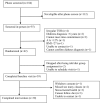Do outcomes from a behavioral weight loss intervention differ in Alabama versus Colorado?
- PMID: 35949282
- PMCID: PMC9358729
- DOI: 10.1002/osp4.583
Do outcomes from a behavioral weight loss intervention differ in Alabama versus Colorado?
Abstract
Background: There are well-established regional differences in obesity prevalence in the United States but relatively little is known about why or whether success in weight loss differs regionally.
Objective: The objective of this study was to determine whether changes in body weight, engagement in physical activity (PA), and psychosocial factors differed in Alabama (AL) versus Colorado (CO) in response to a 16-week behavioral weight loss program.
Design: This is an ancillary study to a weight loss intervention being conducted simultaneously in AL and CO with identical intervention content and delivery in 70 participants (n = 31 AL and n = 39 CO). Body weight, objective (accelerometry) PA, and responses to psychosocial questionnaires (reward-based eating, stress, social support) were collected at baseline and at Week 16.
Results: There were no differences in percent weight loss between states (AL: 10.98%; CO: 11.675%, p = 0.70), and weights at Week 16 were not different for participants in AL and CO (AL: 101.54 ± 4.39 kg, CO: 100.42 ± 3.67 kg, p = 0.84). Accelerometry-derived step count, stepping time, and activity score were all greater at Week 16 for participants in AL compared to participants in CO. Hedonic eating scores were more favorable for participants in AL at baseline (AL: 24.08 ± 2.42; CO: 34.99 ± 2.12, p = 0.0023) and at Week 16 (AL: 18.62 ± 2.70; CO: 29.11 ± 2.19, p = 0.0023). Finally, participants in AL presented more favorable social support scores at Week 16 compared to participants in CO.
Conclusions: Weight loss did not differ between states, suggesting that factors contributing to higher obesity rates in some regions of the United States may not be barriers to weight loss. Further, participants in AL experienced greater improvements in some factors associated with weight maintenance, indicating the need to study regional differences in weight loss maintenance. National Clinical Trial 03832933.
Keywords: behavior; environment; intervention; obesity; physical activity; weight loss.
© 2021 The Authors. Obesity Science & Practice published by World Obesity and The Obesity Society and John Wiley & Sons Ltd.
Conflict of interest statement
Drs. Hill and Wyatt have received royalties from the book State of Slim and are co‐owners of Shakabuku, LLC. Julianne G. Clina, R. Drew Sayer, Caroline W. Cohen, and Navneet Kaur Baidwan report no conflicts of interest.
Figures



Similar articles
-
The effectiveness of web-based programs on the reduction of childhood obesity in school-aged children: A systematic review.JBI Libr Syst Rev. 2012;10(42 Suppl):1-14. doi: 10.11124/jbisrir-2012-248. JBI Libr Syst Rev. 2012. PMID: 27820152
-
The effect of weight management interventions that include a diet component on weight-related outcomes in pregnant and postpartum women: a systematic review protocol.JBI Database System Rev Implement Rep. 2015 Jan;13(1):88-98. doi: 10.11124/jbisrir-2015-1812. JBI Database System Rev Implement Rep. 2015. PMID: 26447010
-
Features predicting weight loss in overweight or obese participants in a web-based intervention: randomized trial.J Med Internet Res. 2012 Dec 12;14(6):e173. doi: 10.2196/jmir.2156. J Med Internet Res. 2012. PMID: 23234759 Free PMC article. Clinical Trial.
-
Can early weight loss, eating behaviors and socioeconomic factors predict successful weight loss at 12- and 24-months in adolescents with obesity and insulin resistance participating in a randomised controlled trial?Int J Behav Nutr Phys Act. 2016 Apr 1;13:43. doi: 10.1186/s12966-016-0367-9. Int J Behav Nutr Phys Act. 2016. PMID: 27036113 Free PMC article. Clinical Trial.
-
Impact of a Health Coach-Led, Text-Based Digital Behavior Change Intervention on Weight Loss and Psychological Well-Being in Patients Receiving a Procedureless Intragastric Balloon Program: Prospective Single-Arm Study.JMIR Form Res. 2024 Jul 31;8:e54723. doi: 10.2196/54723. JMIR Form Res. 2024. PMID: 39083340 Free PMC article.
Cited by
-
Pilot evaluation of a behavioral weight loss program for adults with physical disabilities: State of Slim Everybody usability and feasibility.Obes Sci Pract. 2024 Apr 11;10(2):e750. doi: 10.1002/osp4.750. eCollection 2024 Apr. Obes Sci Pract. 2024. PMID: 38618520 Free PMC article.
References
-
- Björntorp P. Do stress reactions cause abdominal obesity and comorbidities? Obes Rev. 2001;2(2):73‐86. - PubMed
-
- Booth KM, Pinkston MM, Poston WS. Obesity and the built environment. J Am Diet Assoc. 2005;105(5 (Suppl 1)):S110‐S117. - PubMed
-
- Goran MI. Energy metabolism and obesity. Med Clin. 2000;84(2):347‐362. - PubMed
Grants and funding
LinkOut - more resources
Full Text Sources
